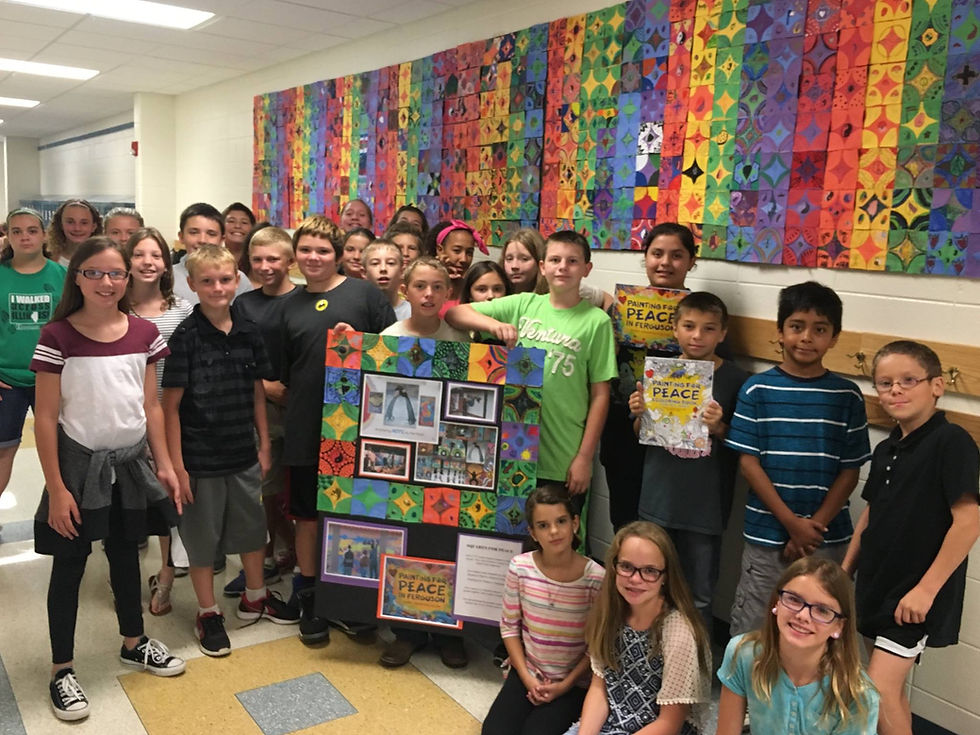One teacher’s quest to teach culture and diversity through art education
- Carol Swartout Klein
- Mar 20, 2017
- 3 min read
Jordan DeWilde is an art teacher at Oregon Elementary in Oregon, IL. who came onto my radar in August 2016 when he started tagging Painting for Peace in Ferguson on Facebook. He’d created a collaborative art project about diversity and inclusion for his students based on the book. As I watched Jordan’s post more and more about his Painting for Peace project on Facebook, I had to know more. Just what was this project? Just who was this Jordan DeWilde?
Turns out, Jordan’s a pretty talented guy with a passion for teaching his students grades 3-6 a variety of concepts through art where he strives “to provide positive representations of all races and ethnicities, both men and women, to show students that art is for everyone.”
I looked up Oregon, IL. It’s in the northern middle part of Illinois, only a couple of hours drive from Chicago and a little more than four hours from St. Louis. It’s a small town, population not even 4,000 according to the last census. It’s not a rich town, but not a poor town. It’s in the middle. In the middle of the state, in the middle of the country. Even the median age is middle at 43.5 years. The kind of town you’d probably drive through in the blink of an eye and barely notice. But, like all those towns, there are families and businesses and schools with students absorbing whatever it is the teachers are teaching. And in this one small, middle of the U.S. of A. town, one teacher is teaching some pretty great things.
Months later Jordan and I connected and I had to ask: how did you find Painting for Peace in Ferguson and what about it inspired you to do this project with your students?
Below is how our conversation unfolded about his art project and his philosophy on teaching, in the hopes of inspiring even more people to create similar projects or helping others do the same:
JD: I strongly believe that an inclusive curriculum promotes a student’s better understanding and respect for cultural differences in our global community.
My sister gave me the Painting for Peace in Ferguson book as a gift for my birthday. She lives in the St. Louis area and came across the book at an adult coloring night at Urban Chestnut Brewery. [Yay, sister!]
CSK: What do you think your students gained from the project? (see more about his project using the Painting for Peace in Ferguson book)
JD: I hope that my students gained a better understanding that art can have a much greater purpose than to be aesthetically pleasing. The Ferguson murals provided comfort to a community in need, and gave the community an opportunity to collaborate creatively.
CSK: Will you share a brief synopsis of the project?
JD: Each of my students, grades 3-6, created an individual square reflecting symbols of peace, love, respect and/or happiness. The squares were then assembled together, arranged by color, to create a large installation in our school. The completed installation was a great example of how each individual helps contribute to a unified whole.

CSK: What would you say to a teacher who wants to teach about crisis, but the school/parents push back?
JD: I would suggest that the teacher look for universal themes that may be less controversial. I introduce a lot of social justice themes, but I don’t often offer my personal opinion. I think the Painting for Peace book does a great job at explaining the events leading up to Ferguson riots in a way that is accessible to children. I read the story and elaborated a little bit, but kept the focus on love and respect, rather than identifying any blame or focusing on the violence. Present students with the facts in an objective way, and give them the opportunity to form their own feelings and opinions. I think as long as a teacher takes this approach, the school and parents will support their efforts. If there is still some pushback, then I would suggest the teacher make a strong, detailed case for why the lesson is important for students.
CSK: Why is art an important part in teaching about helping/crisis, etc.?
JD: I believe art offers a unique opportunity to talk about crisis and to do so in a positive way. Art has been used throughout history to express feelings of injustice and crisis. Some students may approach an artwork easier than they would reading a text about the same issue. I think it is important to provide students with an opportunity to express how they feel visually and creatively. Students have a lot to say about their own lives and how they see the world.
You can find out more about Jordan’s class projects on his Facebook page: Mr. DeWilde Art.


Comments